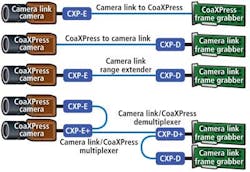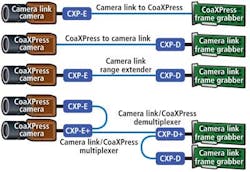Camera interfaces: Converters extend the reach of Camera Link cameras
For years, the Camera Link standard has been the de-facto high-speed camera interface for those wishing to transfer image data at speeds as fast as 850Mbytes/sec. Despite these high data rates, however, the Camera Link standard has its limitations, the most notable being the maximum 3m camera to computer distance specified in the standard.
Because of this, many companies have developed novel methods to extend this distance. Components Express Inc (CEI; Woodridge, IL; www.componentsexpress.com) for example, offers its BIT MAXX intelligent cabling products that employ equalization and pre-emphasis techniques to extend the camera to computer distance to 7m at 85MHz clock rates and further (if lower clock rates can be employed).
Those systems integrators wishing to extend their Camera Link to computer distances over longer distances can also chose to use products such as the iPORT PT1000-CL IP engine from Pleora (Kanata, Ontario, Canada; www.pleora.com), a video transmitter that enables Gigabit Ethernet (GigE) connections between base-configuration Camera Link cameras and PCs using the GigE Vision standard. In operation, the iPORT PT1000-CL IP engine captures data from a Camera Link camera, converts it to IP and sends it to PCs over GigE links or LANs using Cat-5 cable.
Today, the emergence of high-speed cameras and sensors requires image data to be transferred at data rates faster than the 850MByte/s maximum specified by the Camera Link standard. To accomplish this, standards such as the 10Gigabit Ethernet allow data to be transferred at rates of 10Gbits/s, faster than the extended 6.8Gbits/s of the Extended Full version of the Camera Link interface.
For even faster data transfer, the CoaXPress (CXP) standard offers an asymmetric point to point serial communication standard that is scalable over single or multiple coaxial cables. With a high-speed downlink of up to 6.25Gbits/s per cable for images and data, and a low speed 20Mbps uplink for communications and control, the CXP standard allows approximately 100m camera to computer distances to be achieved. Already, over ten manufacturers offer cameras that support the CXP interface (see "CoaXPress interface standard adopted by camera vendors at VISION show," Vision Systems Design, January 2013; http://bit.ly/XSGB5B).
Now, systems integrators can take advantage of the extended camera to computer distances offered by the CXP standard, thanks to a Camera Link to CXP converter from Tecphos (Falcon, CO; www.tecphos.com). According to Barry Walker, Vice President and Founder of Tecphos, the company's digital converter is reconfigurable and can be operated in a number of different modes.
In the simplest of these, the converter can accept a Base Camera Link output (clocked at up to 85MHz) and output CXP-3 data as fast as 3.125 Gbits/s over a CXP interface. In this mode, existing users of Camera Link Base cameras can configure systems that extend the camera to computer distance from 3m to 100m.
However, because the digital converter features an on board TI MSP430 microcontroller and a Lattice Semiconductor ECP3 FPGA array, it can also be configured as a CXP-3 (3.125 Gbits/s) to Base Camera Link converter. This mode is useful for developers who wish to leverage existing Camera Link frame grabbers with newer CXP cameras.
Finally, the converter may be programmed to accept both Camera Link Base and CXP inputs and output CXP data at rates of up to 3.125 Gbits/s. Thus, data from two separate cameras can be transmitted over the CXP interface.
According to Walker, the digital converter will be the first in a number of products offered by the company. "In future," he says, "Techphos will introduce converters that support Medium, Full, and Dual Base Camera Link interfaces, multi-lane CXP interfaces, and higher speed CXP-6 with speeds up to 6.25Gbits/s." All of the company's digital converter product line will be distributed by Saber1 Technologies (Lowell, MA; www.saber1.com).
Of course, for some, even 100m camera to computer cable lengths may not suffice. For these applications, several manufacturers including EDT (Beaverton, OR; http://www.edt.com) and Phrontier Technologies (Lake Forest, CA; www.phrontier-tech.com) offer Camera Link to fiber converters that can extend camera to computer distances over kilometer distances.
Vision Systems Articles Archives

